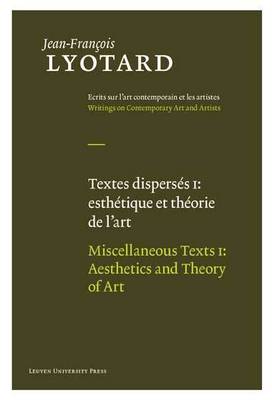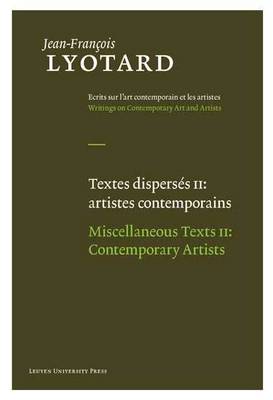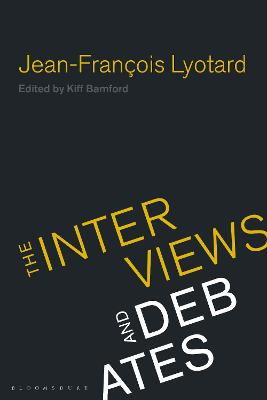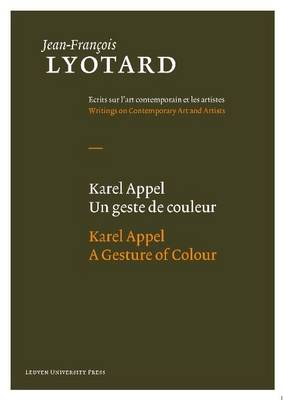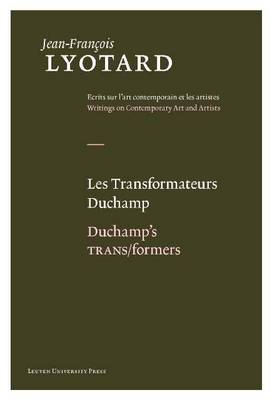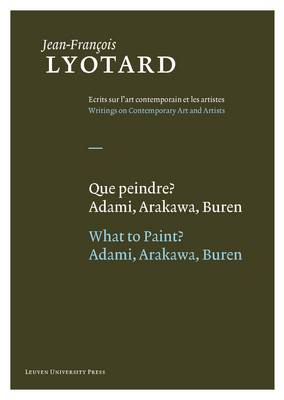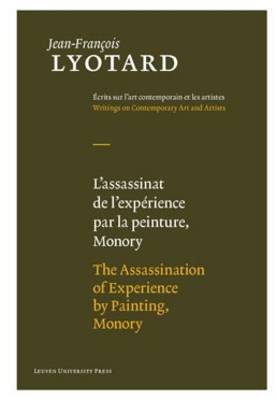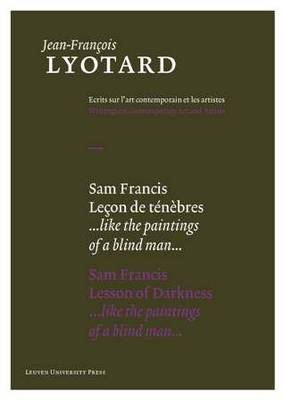Jean-Francois Lyotard: Writings on Contemporary Art and Artists
2 primary works • 8 total works
Volume 1
Volume 2
TWO-VOLUME SET!
Buy volume 4, I & 4, II together and receive € 20 discount.
You only pay €109 instead of € 129! >
Ce second tome du quatrième volume rassemble trente-neuf textes de Lyotard qui concernent vingt-six artistes contemporains importants et novateurs : Luciano Berio, Richard Lindner, René Guiffrey, Gianfranco Baruchello, Henri Maccheroni, Riwan Tromeur, Albert Ayme, Manuel Casimiro, Ruth Francken, Barnett Newman, Jean-Luc Parant, François Lapouge, Sam Francis, André Dubreuil, Joseph Kosuth, Sarah Flohr, Lino Centi, Gigliola Fazzini, Bracha Lichtenberg Ettinger, Henri Martin, Michel Bouvet, Corinne Filippi, Stig Brøgger, François Rouan, Pierre Skira et Béatrice Casadesus. Plusieurs de ces textes sont des contributions à des catalogues dont certains sont inaccessibles ou introuvables. Ce volume est illustré par plus de soixante images, pour la plupart en couleur, d'oeuvres d'art commentées par Lyotard dans ces textes.
On comprend que Lyotard, au titre d'une esthétique de la présence matérielle, favorise la peinture. L'art de peindre, pour qu'il y ait présence, doit se rendre à ce rien qui vibre entre le vide et le plein, un air, un clinamen, un neutre, une nuance, un timbre.
This second book of the fourth volume in the series brings together thirty-nine essays by Lyotard that deal with twenty-seven influential and innovative contemporary artists: Luciano Berio, Richard Lindner, René Guiffrey, Gianfranco Baruchello, Henri Maccheroni, Riwan Tromeur, Albert Ayme, Manuel Casimiro, Ruth Francken, Barnett Newman, Jean-Luc Parant, François Lapouge, Sam Francis, André Dubreuil, Joseph Kosuth, Sarah Flohr, Lino Centi, Gigliola Fazzini, Bracha Lichtenberg Ettinger, Henri Martin, Michel Bouvet, Corinne Filippi, Stig Brøgger, François Rouan, Pierre Skira, and Béatrice Casadesus. Some of these texts were originally written as contributions to catalogues; others were published in now-inaccessible journals. This volume is illustrated with more than sixty images, mainly in colour, of works of art discussed by Lyotard in these writings.
This publication is GPRC-labeled (Guaranteed Peer-Reviewed Content).
Key concepts from Lyotard’s thought – the differend, the postmodern, the immaterial – are debated and discussed across different time periods, prompted by specific contexts and provocations. In addition there are debates with other thinkers, including Emmanuel Levinas and Jacques Derrida, which may be less familiar to an Anglophone audience. These debates and interviews help to contextualise Lyotard, highlighting the importance of Marx, Freud, Kant and Wittgenstein, in addition to the Jewish thought which accompanies the questions of silence, justice and presence that pervades Lyotard’s thinking.
Epilogue by Christine Buci-Glucksmann
Karel Appel. A Gesture of Colour is the first of a series of six volumes, bringing together the most important writings of Jean-François Lyotard (1924 - 1998) on contemporary art and artists. The book he devoted to the art of Karel Appel (1921 - 2006) is doubtlessly one of the most complete and inspired texts of all the writings included in the series. Neither the original French manuscript nor the English translation have ever been published, and their presentation face to face should constitute a considerable plus.
In this book, Lyotard presents Karel Appel's "matterism" as an offer of presence, presence deferred - it is the visual where every predicate is suspended, the visual touched, "gesture" of colour more than property of colour, appearance at the edge of the abyss. Christine Buci-Glucksmann's epilogue indicates the position of Karel Appel. A Gesture of Colour within the whole of Lyotard's writings on art, considering equally the philosopher's subsequent work.
Winner of the Plantin Moretus Prize 2010 for the best designed book in the category textbooks and academic publications
Photo Credits: Van Looveren & Princen
Les Transformateurs Duchamp/Duchamp's TRANS/formers
by Jean-Francois Lyotard
Duchamp's TRANS/formers is the third in a series of six volumes that exhaustively bringstogether the writings of Jean-François Lyotard (1924-1998) on contemporary arts and artists. This collection of essays, written between 1974 and 1977 in the middle of the time of Duchamp's rediscovery in France, was published by Editions Galilée (Paris) in 1977 and in English translation by The Lapis Press (Los Angeles) in 1990. This volume republishes the two versions face to face, including the drawings, diagrams and images of the original edition.
Duchamp's TRANS/formers reconstructs the Large Glass and Given, Duchamp's two major works that glorify the body in its topological conceptuality. The book introduces the question of the advent and the event of art, and invites us furthermore to consider the debt that philosophical commentary owes to the artistic gesture. This essay in philosophical aesthetics also includes reflections on the question of style, on the relation between the notions of transformer and performance, and on recourse to the machine in order to reveal the cunning nature of the machinations in play.
The most important writings of Lyotard on contemporary art in English for the first time
Seven writings assembled in the context of the philosophy of art that Jean-François Lyotard developed in the nineteen-eighties, at the time of the Differend(1983) and of the ‘Kantian turn' leading to the Lessons on the Analytic of the Sublime (1992), are here published for the first time in English translation. The texts focus on three artists with widely divergent aesthetic orientations: the colourist-draughtsman Valerio Adami, the conceptual metaphysician Shusaku Arakawa, and Daniel Buren, the ‘pragmatist of the invisible'. These three protagonists share the notion that the interest in art does not lie in the simple denotation of a frame of reference, but in the connotations of material nuances, in flavours, in tones-in one word, the visual that is barely revealed in the anamnesis that guides the visible and provokes the essential inquietude of the aesthetic experience. What to Paint? Not reality or a ‘world', nor a rich subjectivity, nor even the phantasms of dreams or ideals of being-together, but the act of painting itself, and, beyond the performance of the painter, the presence of matters, a presence that in Arakawa's word is quite obviously blank, elusive.
This publication is GPRC-labeled (Guaranteed Peer-Reviewed Content)
The Assassination of Experience by Painting, Monory
by Jean-Francois Lyotard
Final volume in the series 'Jean-François Lyotard: Ecrits sur l'art contemporain et les artistes / Writings on Contemporary Art and Artists'!
Lyotard met Jacques Monory in 1972, and the text on him published at that time was the first that Lyotard dedicated to contemporary art since Discourse, Figure. Lyotard's interest in the plastic arts thus fits fully within the setting of his political preoccupations. The artist-protagonist stages the recurring motifs that fascinate Lyotard: the scene of the crime, the revolver, the woman, the victim, glaciers, deserts, stars. The atmosphere of the essays on Monory is "Californian". Monory's imaginary repertoire goes well beyond the masters of modernity and is in line rather with a "modern contemporary surrealism". Both Lyotard and Monory live the "dilemma of Americanisation", the America represented by cinema, fashion, novels, music. It is in this atmosphere that Lyotard and Monory will finally evoke their supreme experience of difference: desire and fear, exultation and a profound malaise. The plastic universe of Monory and the aesthetic meditations of Lyotard are in perfect symbiosis. Sarah Wilson's epilogue thoroughly outlines both the history of a friendship, and at the same time the intellectual and artistic climate of the nineteen-seventies.
This publication is GPRC-labeled (Guaranteed Peer-Reviewed Content).
Selected for the 2012 AAUP Book, Jacket and Journal Show in the category 'Scholarly Illustrated'!
Awarded with 'Best Vormgegegeven Boek 2011' for the best designed book in the category business and academic publications
Sam Francis. Lesson of Darkness is the second of a series of six volumes, bringing together the most important writings of Jean-François Lyotard (1924-1998) on contemporary art and artists. This second volume introduces forty-three poetical reflections and comments on the work of the well-known Californian painter Sam Francis (1923-1994). This edition reprints the English text published in 1993, which is no longer available, face to face with the previously unpublished French original. It also reproduces in full colour all forty-three paintings commented upon by Lyotard.
In Lyotard's opinion ‘the work [by Sam Francis] pays homage to the visible marvel and bears witness to the visual enigma'. Lyotard discovers in these poetic reflections the subtle variety of meanings in the use of colour in Sam Francis's paintings.
Photos: Van Looveren & Princen
